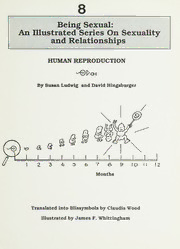
Being Sexual: An Illustrated Series on Sexuality and Relationships - Human Reproduction PDF
Preview Being Sexual: An Illustrated Series on Sexuality and Relationships - Human Reproduction
HUMAN REPRODUCTION ~O)Pa y By Susan Ludwig and David Hingsburger Months Translated into Blissymbols by Claudia Wood Illustrated by James F. Whittingham BEING SEXUAL: AN ILLUSTRATED SERIES ON SEXUALITY AND RELATIONSHIPS This 17-book series provides important sexuality education for young adults and adults. The clear, straightforward text and engaging illustrations are particularly helpful for people with developmental disability, problems with literacy, learning or communication, or anyone who uses Blissymbols. The content, philosophy and ideas expressed are those of the authors. Books were reviewed by SIECCAN Board members who are professionally involved in sex education, counselling and therapy and by consumers, parents and educators. Blissymbolics Communication International (BCI) co-ordinated Blissymbol translation of major portions of each book in the Being Sexual series using approximately 150 recently-developed symbols for sexuality. Claudia Wood translated all books except for volume 4 on Adolescence which was translated by Ruth Harrington and Jinny Storr. Blissymbols used herein are derived from symbols described in Semantography, origi- nal copyright © C.K. Bliss 1949. © Blissymbolics Communication International, 250 Ferrand Drive, Suite 200, Don Mills, Ontario, Canada MSC 3P2. Exclusive licensee 1982. The series is co-authored by Dave Hingsburger, an author and lecturer who has ex- tensive experience as a counsellor and therapist for people with developmental disabilities, and Susan Ludwig, a nurse-educator with the Sexual Health Team, York Region Public Health who specializes in sexuality education for people with develop- mental disabilities. The authors acknowledge the assistance and support of York Region Public Health during the writing phase of the project, the imaginative input of Claudia Wood, and the special contribution of James F. Whittingham who created over 1200 drawings to illustrate the series. The first printing of Being Sexual was made possible by funding from: Blissymbolics Communication International, Sir Joseph Flavelle Foundation, Learnxs Foundation, George Lunan Foundation, Claudia Wood, and Health Services and Promotion Branch, Health and Welfare Canada, through the AIDS Information and Education Contribution Program. Published by SIECCAN, the Sex Information and Education Council of Canada, 850 Coxwell Avenue, East York, Ontario, Canada M4C 5R1 (416-466-5304; 416-778-0785 FAX). © SIECCAN 1993 Canadian Cataloguing in Publication Data Main entry under title: Being Sexual: an illustrated series on sexuality and relationships Translated into Blissymbols by Claudia Wood, Ruth Harrington and Ginny Storr. Partial contents: v. 8. Human reproduction. ISBN 1-895866-00-6 (set) ISBN 1-895866-08-1 (v. 8) 1. Sex I. Wood, Claudia, 1947- _.._II. Sieccan HQ21.B44 1993 306.7 C93-093380-X HUMAN REPRODUCTION 1 Human Reproduction “OPa H (conception + to cause + baby) Each time a man and a woman have sexual intercourse, there is the possibility that the woman could become pregnant and later give birth to a baby. This book is about these events and giving birth. It is about reproduction. ok vp OL +10 @. Sexual intercourse can cause pregnancy and later (the) birth of (a) child. A ilearOP> c ae This book is about reproduction. Ejaculation tL! (erection + sperm + intensity) When a man ejaculates into a woman’s vagina, millions of sperm are released into her body. These sperm move up the vagina and pass through the cervix into the uterus. ule Ge se 11,000/000 ‘sate <> Dale CAD (A) man ejaculates millions of sperm into (a) woman’s vagina. See ACY) END) (The) sperm pass through (the) cervix into (the) uterus. Private ala ejaculation a Fallopian Tubes a-© (tube + egg + plural indicator) From the uterus, the sperm move upwards and into the fallopian tubes. This may take two or more days. » DMR SSaPso: rice@ :a From (the) uterus (the) sperm enter (the) fallopian tubes. This may take two days or more. Egg Ovary ©) UO (pictograph) (container + egg) In the meantime, an egg may have been developing in an ovary. When it is ready, it will begin to travel through the fallopian tube toward the uterus. ©! > FO) ce OMIeE (An) egg from (the) ovary may travel through (the) fallopian tube toward (the) uterus. fallopian tube Fertility KS (Sperm + egg + description before the fact indicator) During the time when the egg is released and begins to travel in the fallopian tube, the woman is fertile. This means that the egg is ready to meet witha sperm and could be fertilized. a) SG 5 b CSCmiven) Meson While (the) egg goes from (the) ovary toward (the) uterus, (a) woman is fertile. egg Conception Pregnant A (combination of sperm and egg) (conception + woman + description indicator) If the egg meets sperm in the fallopian tube, the sperm will try to enter the egg. One sperm may be successful in entering the egg. If a sperm enters the egg, this is called conception. The woman is now pregnant. > ene bie eee If (the) sperm enters (the) egg, (the) woman is now pregnant. © Gy, conception Embryo (body + life/half size) Soon after the egg and the sperm combine, the fertilized egg will begin to develop. It travels to the uterus and implants itself in the lining. It is now called an embryo. An embryo doesn’t look like a baby, but it develops “buds” that will later become the baby’s legs and arms. el) - >»! @) + 0 ©). (The) fertilized egg travels to (the) uterus and becomes (an) embryo. Fetus Gy) (bo+d byaby ) After the embryo has developed for two months, the body parts are quite obvious. It is now called a fetus. A fetus looks like a tiny baby, but it needs to grow and develop more inside the mother before it can survive on its own. | 2D @ 70 @. After two months (the) embryo becomes (a) fetus.
